Table of Contents
ToggleLighting Design for Tennis Courts
When designing lighting for tennis courts, whether outdoor or indoor, it is essential to ensure that the lux level (brightness), uniformity, and the ratio between horizontal and vertical illuminance meet specific requirements. Let’s delve into a case study to understand these requirements better.
Lux (Brightness) Level Requirement
Understanding Lux Levels
In designing tennis court lighting, achieving the correct lux level is crucial for player comfort and overall functionality. Lux is a measure of illumination indicating how much light is cast on a given surface area. For recreational tennis courts, a lux level between 300 and 500 is generally recommended. Competitive courts may require up to 750 lux. Given that the tennis court in this scenario is part of a sports club primarily intended for recreational play but occasionally hosting mid-level competitions, a lux level of 400 was deemed appropriate. This level provides sufficient brightness for recreational activities while being adequate for mid-level competitions.
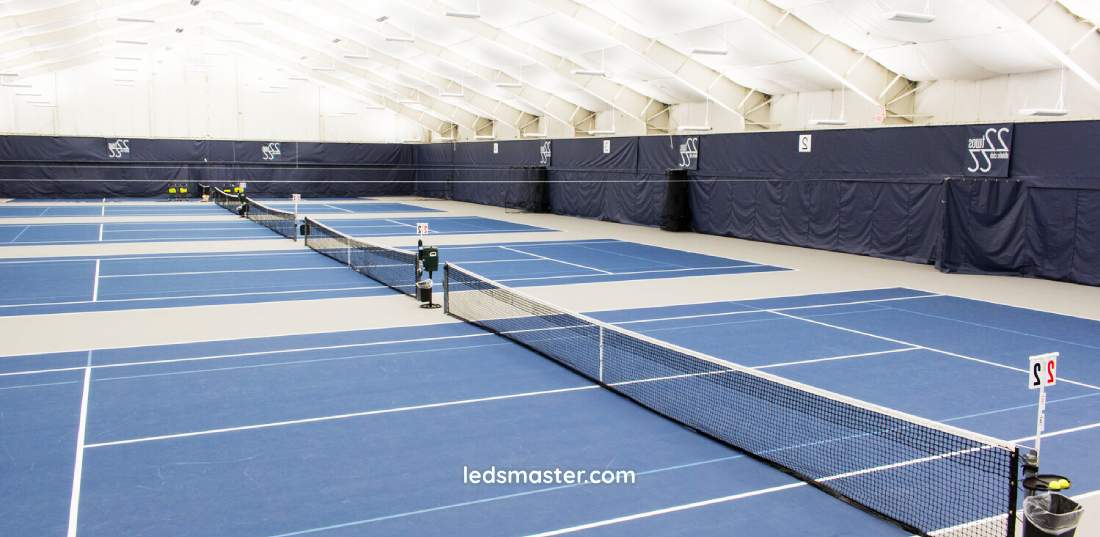
Importance of Proper Lux Levels
Selecting the right lux level is vital for several reasons. Firstly, it ensures player comfort and performance. Appropriate lighting allows players to see the ball clearly and react quickly, enhancing their gameplay. Excessive brightness can cause glare, leading to visual discomfort and negatively affecting performance. Conversely, inadequate lighting results in poor visibility, increasing the risk of accidents and diminishing the quality of play.
Secondly, proper lux levels contribute to energy efficiency. Overly bright lighting not only increases electricity consumption but also raises operational costs. By optimizing the lux level to 400, we strike a balance between adequate illumination and energy efficiency, minimizing unnecessary power usage and resulting in significant cost savings.
Lastly, setting the correct lux level helps manage installation and maintenance costs. Higher lux levels often require more powerful or additional lighting fixtures, driving up installation expenses. Additionally, maintaining excessively bright lights leads to higher replacement and maintenance costs. By setting the lux level at 400, we ensure that the lighting system is both cost-effective and sustainable.
Energy-Efficient Solutions
To achieve the desired lux level of 400, we utilize 400W LED lights. These lights are highly efficient and capable of replacing 1000W metal halide and 4000W halogen flood lights. This replacement results in up to 90% energy savings, making LED lights an eco-friendly and cost-effective solution. For those looking to maintain the same light lux level, replacing luminaires one by one is a convenient approach.
Customizing the Lighting Design
Understanding the specific needs of the sports club is essential before finalizing the lighting design. The club owner, unfamiliar with the appropriate brightness levels, relied on our expertise to recommend the optimal lux level. By carefully considering the dual-purpose usage of the court, we ensured the lighting design met both recreational and competitive requirements.
Enhancing Player Experience
The right lux level enhances the overall player experience by providing a well-lit environment that supports both casual play and competitive matches. Adequate lighting reduces eye strain and improves visibility, allowing players to focus on their game. By achieving a lux level of 400, we create a balanced lighting environment that meets the needs of all players.
Lighting Uniformity
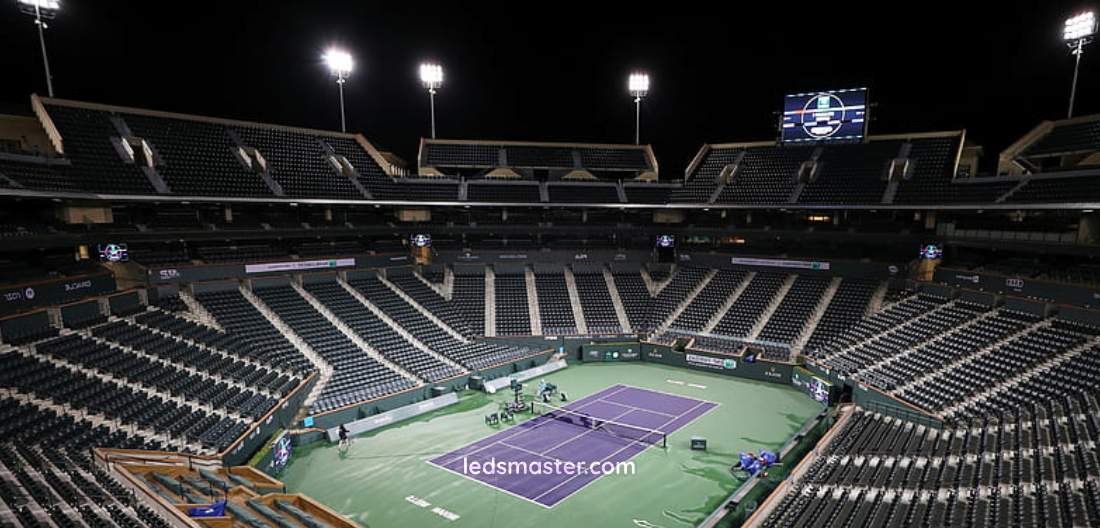
Addressing Poor Lighting Uniformity
Poor lighting uniformity, characterized by bright spots in the middle of the court, can adversely affect players’ vision and performance. To address this issue, selecting flood lights with a large beam angle is beneficial. Large beam angles provide more dispersed area lighting, which is particularly useful if the light pole is not sufficiently high. This approach ensures that the entire court is evenly illuminated, reducing the occurrence of bright spots and enhancing the overall lighting quality.
Benefits of Large Beam Angles
Flood lights with large beam angles distribute light more evenly across the court, minimizing the risk of shadows and dark spots. This even distribution is essential for maintaining consistent visibility, allowing players to track the ball and their opponents effectively. Additionally, large beam angles reduce the need for multiple lighting fixtures, making them a cost-effective solution for achieving optimal lighting uniformity.
Photometric Lighting Reports
To ensure the highest level of lighting uniformity, our engineers can provide a free photometric lighting report and design. This report analyzes the distribution of light across the court and identifies areas that may require adjustments. By utilizing photometric data, we can design a lighting system that delivers consistent illumination and meets the specific needs of the tennis court.
Optimizing Lighting Performance
Achieving optimal lighting uniformity involves a combination of strategic fixture placement and selecting the right lighting equipment. Our team works closely with clients to understand their specific requirements and design a lighting system that maximizes performance. By addressing uniformity issues and providing tailored solutions, we enhance the overall lighting experience for players and spectators alike.
What Features Should the Best Tennis Court Lighting Include?
Selecting the Right Power for Tennis Court Floodlights
Understanding Power Requirements for Tennis Courts
Determining the appropriate power for tennis court floodlights involves several critical factors to ensure that the lighting is both effective and efficient. A fundamental consideration is the required brightness level, measured in lux. For instance, to achieve a brightness of 200 lux on a 200 square meter tennis court, the total luminous output required is 40,000 lumens. This level of brightness is essential for both recreational and competitive play, ensuring that players have adequate visibility of the ball and the court.
Calculating Power Requirements
The power needed for LED floodlights can be calculated using the formula:
Power required = Total lumens required / Lumens per watt
Applying this formula to our example:
Power required = 40,000 lumens / 150 lumens per watt = 267 watts
This calculation indicates that approximately 267 watts of LED lighting power are needed to achieve the desired brightness level. However, to accommodate for factors such as light distribution and potential inefficiencies, using 300-watt LED lights is a practical approach. These slightly higher-powered lights ensure that the lighting requirements are met effectively and provide a margin of safety to cover any potential discrepancies.
Benefits of Using LED Lights
LED floodlights are an excellent choice for tennis courts due to their superior energy efficiency compared to traditional metal halide or halogen lamps. LEDs consume significantly less power, which translates to substantial energy savings over time. They also have a longer lifespan, often exceeding 50,000 hours, which reduces the frequency of replacements and maintenance costs. Additionally, LEDs produce less heat compared to traditional lighting sources, enhancing the comfort of players and reducing the risk of overheating.
Considerations Beyond the Play Area
While the power calculation primarily addresses the illumination of the play area, it is also important to consider additional areas such as spectator seating zones, pathways, and surrounding areas. These areas may require additional lighting to ensure safety and improve the overall experience for spectators. A comprehensive lighting design should take these factors into account to create a well-lit and functional environment.
For a more precise and detailed lighting design, consulting with lighting professionals is advisable. Engineers can provide expert analyses and recommendations tailored to the specific dimensions and needs of the tennis court, including any additional areas that need to be illuminated.
Availability of LED Lights
Finding LED lights with specific power ratings is straightforward due to the wide range of options available. Manufacturing capabilities include a variety of floodlights ranging from 100 watts to 10,000 watts. This extensive selection ensures that the appropriate luminaries can be matched to any sports field or facility, regardless of its size or lighting requirements.
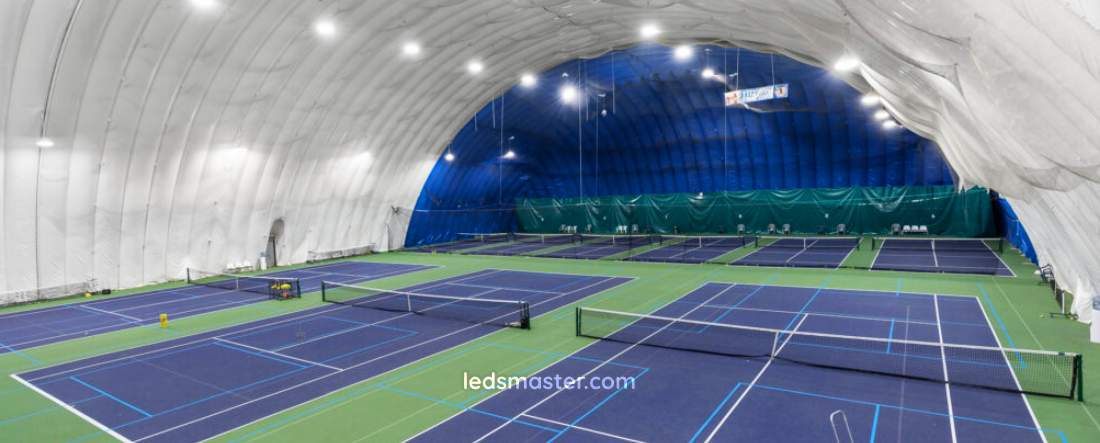
High Color Rendering Index (CRI) for World-Class Tournaments
Importance of CRI
The Color Rendering Index (CRI) is a critical factor in tennis court lighting, as it measures how accurately colors are rendered under artificial light. CRI values range from 0 to 100, with higher values indicating a more accurate representation of colors. For world-class tournaments such as Wimbledon and the US Open, the CRI of the lighting should be at least 80.
A high CRI is essential for maintaining the visual quality of the game. It ensures that colors are seen as they truly are, which is important not only for players but also for spectators and broadcasters. Accurate color rendering enhances the overall visual experience, making it easier to distinguish between different elements on the court and ensuring that the event is visually engaging.
Achieving High CRI
To achieve a high CRI, high-quality LED lights with advanced color rendering technology are used. These LEDs are designed to emit light with a spectrum that closely resembles natural daylight, resulting in vibrant and true-to-life colors. This high level of color accuracy is crucial for professional events where every detail matters, and it also enhances the overall atmosphere of the event.
Wide Range of Color Temperatures
Understanding Color Temperature
Color temperature, measured in Kelvin (K), defines the color appearance of light. It affects the mood and functionality of the lighting. Most tennis courts require cool white light, typically ranging from 5000K to 6000K. This color temperature provides a bright and neutral light that is suitable for sports environments, as it closely mimics daylight and helps players maintain focus.
Customizing Color Temperature
However, some tennis clubs may have specific preferences for different color temperatures. For example, warm white light, with a range from 2800K to 3500K, is sometimes chosen for its softer and more inviting appearance. This color temperature can create a more comfortable and relaxed atmosphere, which may be preferred for recreational settings or clubs aiming to create a welcoming environment.
The flexibility to choose between different color temperatures allows for customization based on the specific needs and preferences of the court’s users. By offering a range of color temperatures, we ensure that the lighting not only meets functional requirements but also complements the overall ambiance of the tennis facility.
Using Solar Power for Outdoor High Mast Tennis Court Lighting
Introduction to Solar-Powered Lighting
We are excited to introduce our latest innovation in outdoor tennis court lighting: the hybrid power system. This advanced system integrates solar power panels directly onto the high mast poles or the lamp bodies. Our new technology has significantly improved the energy efficiency of solar energy utilization by 30% compared to previous models. By harnessing this renewable energy source, you can achieve substantial reductions in electricity costs while contributing to environmental sustainability.
Benefits of Solar-Powered Lighting
The hybrid power system offers several advantages over traditional lighting methods. With solar panels integrated into the lighting system, the battery can support the floodlights for up to 3.5 hours of continuous illumination. This feature ensures that the tennis court remains well-lit even during extended playtime. Additionally, the system includes a conventional mode option, allowing users to switch to standard electricity when solar energy is insufficient or not in use. This dual-mode functionality provides flexibility and reliability, ensuring uninterrupted lighting regardless of solar availability.
Durability and Installation Considerations
One of the primary concerns with integrating solar power into high mast lighting systems is maintaining the water-proof integrity of the floodlights. Our solar-powered lamps are designed with advanced materials that do not compromise the water-proof function of the lighting fixtures. We use high-quality, durable materials to enhance the longevity and performance of the lamps, ensuring that they withstand various environmental conditions. For detailed specifications and further information about our solar-powered lamps, our engineers are available to provide expert consultation.
Metal Halide, Halogen, or Mercury Replacement
Advantages of Replacing Old HID Lights
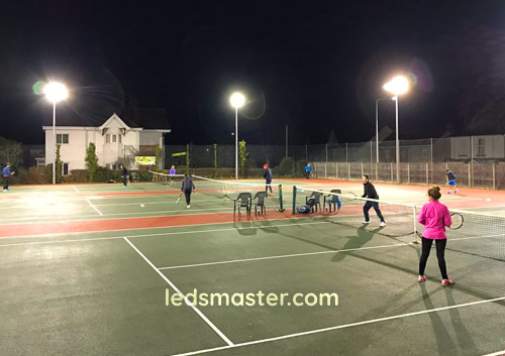 Many tennis center owners are increasingly opting to replace their outdated high-intensity discharge (HID) lights, such as metal halide, halogen, or mercury vapor lamps, with modern LED technology. This transition offers significant benefits, including instant energy savings and extended lifespan of the lighting fixtures. LED lights are known for their superior efficiency and durability compared to traditional lighting sources.
Many tennis center owners are increasingly opting to replace their outdated high-intensity discharge (HID) lights, such as metal halide, halogen, or mercury vapor lamps, with modern LED technology. This transition offers significant benefits, including instant energy savings and extended lifespan of the lighting fixtures. LED lights are known for their superior efficiency and durability compared to traditional lighting sources.
Comparative Lighting Efficiency
To illustrate the efficiency of LED lights, consider the comparison between a 500-watt LED light and a 1000-watt metal halide lamp. The lighting efficiency of LEDs can reach up to 130 lumens per watt (lm/W), whereas metal halide lamps typically offer about 65 lm/W. Thus, a 500-watt LED light with an efficiency of 130 lm/W can replace a 1000-watt metal halide lamp. For a more accurate and tailored analysis of lighting efficiency, our engineers are available to assist through our contact form.
High Luminous Efficacy of Our LED Tennis Court Floodlights
Understanding Luminous Efficacy
One common misconception is that higher power automatically equates to brighter light. However, brightness is not solely determined by power; it is also influenced by the luminous efficacy of the lighting fixtures. Luminous efficacy measures how effectively a light source converts power into brightness. For example, a 400-watt metal halide bulb with an efficacy of 65 lm/W provides a lumen output of 26,000 lumens. In contrast, a 250-watt LED light with an efficacy of 130 lm/W delivers a lumen output of 32,500 lumens.
Energy Efficiency and Brightness
The key to achieving high brightness with lower power consumption lies in selecting lighting fixtures with high luminous efficacy. Our LED floodlights exemplify this principle by providing superior brightness with lower power requirements. By opting for high-efficacy LED lights, you can achieve greater illumination while reducing overall power consumption, making them a highly efficient choice for tennis courts.
Lighting That Can Resist High Temperatures for Outdoor Tennis Courts
Managing Heat in Outdoor Lighting
Outdoor tennis courts are exposed to a range of environmental conditions, including intense heat from direct sunlight. High temperatures can lead to overheating, which can damage the lighting fixtures and reduce their lifespan. To address this issue, it is crucial to select lighting solutions designed to withstand high temperatures. Our products leverage advanced LED flip-chip technology, which effectively reduces heat generation by approximately 20% compared to similar products on the market.
Advantages of LED Technology
LED lighting is particularly well-suited for high-temperature environments due to its energy efficiency. Unlike traditional high-intensity discharge (HID) lamps, which convert 40 to 50% of their energy into heat, LED lights convert around 95% of their energy directly into lumen output. This significant reduction in heat generation not only helps to mitigate overheating issues but also enhances the overall performance and longevity of the lighting system. By replacing HID lamps with LED lights, you can effectively manage high temperatures and ensure reliable illumination for your tennis court.
The Importance of Waterproof Lighting
Protecting Lights from Adverse Weather
Once installed, tennis court floodlights are exposed to various weather conditions, including rainstorms, snow, and other harsh elements. To ensure the durability and functionality of the lights, it is essential to use products designed with robust waterproofing features. Our floodlights are built to withstand challenging weather conditions, offering an IP66 waterproof rating. This rating signifies that the lights are fully protected against dust ingress and can withstand powerful jets of water, making them suitable for outdoor use in all weather conditions.
Special Considerations for Unique Environments
In some regions, additional environmental factors may impact the performance of outdoor lighting. For example, areas prone to acid rain may require extra protection to prevent damage. In response to such conditions, we have reinforced our tennis court lights by adding a thin polycarbonate cover over the aluminum shell. This additional layer of protection enhances the durability of the lights and helps to ensure their continued functionality despite exposure to corrosive elements.
Performance in Extremely Low Temperatures
Ensuring Functionality in Cold Weather
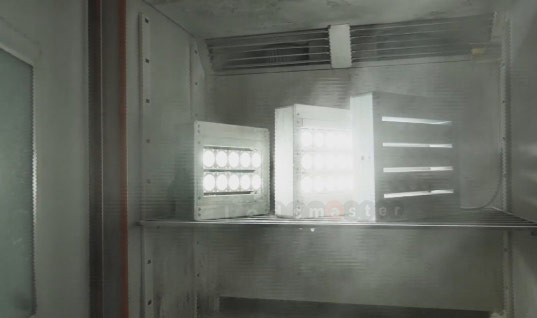 Outdoor tennis courts may also face challenges in extremely cold temperatures, particularly during winter months or in regions that experience heavy snowfall. Traditional HID lamps often struggle to operate effectively under low-temperature conditions due to their delicate structure. In contrast, our LED lights are rigorously tested to ensure reliable performance in cold environments. Our LED lights have passed extensive low-temperature laboratory tests and can function effectively at temperatures as low as -40°C.
Outdoor tennis courts may also face challenges in extremely cold temperatures, particularly during winter months or in regions that experience heavy snowfall. Traditional HID lamps often struggle to operate effectively under low-temperature conditions due to their delicate structure. In contrast, our LED lights are rigorously tested to ensure reliable performance in cold environments. Our LED lights have passed extensive low-temperature laboratory tests and can function effectively at temperatures as low as -40°C.
Benefits of LED Lights in Cold Conditions
The ability of LED lights to operate in extremely low temperatures makes them an excellent choice for outdoor sports facilities that need to maintain functionality throughout the year. Unlike HID lamps, which may fail to start or perform poorly in cold conditions, LED lights offer consistent performance and reliability. This ensures that tennis courts remain well-lit and usable, regardless of the weather conditions.
Lighting for Indoor Tennis Courts Should Have a Good Heat Dissipation System
The Importance of Effective Heat Dissipation
In indoor tennis courts, managing heat is crucial to maintaining the performance and longevity of lighting systems. Excessive and persistent heat can significantly damage LED chips, leading to reduced brightness and a shortened lifespan of the lights. To address this challenge, we have developed an exclusive and highly effective heat dissipation system designed to ensure optimal performance and durability.
Advanced Heat Sink Technology
Our heat dissipation system incorporates a dense network of aluminum fins attached to the back of each light fixture. These fins provide a large surface area that facilitates efficient heat transfer away from the LED chips. By maintaining proper heat dissipation, we can prevent overheating and ensure that the lights continue to operate at their best, delivering consistent illumination and a longer service life.
No Warm-Up Time Required
Instant Illumination with LED Technology
The evolution of lighting technology has brought significant improvements in efficiency and convenience, especially with the adoption of LED lights for outdoor tennis courts. Unlike traditional metal halide lamps, which require a warm-up period of around 15 minutes and are prone to frequent replacements due to their relatively short lifespan, LED lights offer immediate benefits.
Advantages of LED Lighting
LED lights do not require any warm-up time; they can be turned on and off instantly. This feature not only enhances convenience but also improves energy efficiency and operational flexibility. With LED technology, tennis courts can enjoy consistent, reliable lighting without the delays and maintenance challenges associated with older lighting systems.
Life Span of the Tennis Court Flood Lamp
The Value of Long-Lasting Lighting Solutions
Selecting long-lasting flood lamps is essential for reducing overall maintenance costs and ensuring reliable lighting. Frequent replacements of traditional lights can lead to significant expenses, including the cost of new fixtures and reinstallation. By choosing high-quality LED lights, you can avoid these costs and benefit from a more cost-effective lighting solution.
Comparing LED and Traditional Lighting Lifespans
LedsMaster LED luminaires are designed to offer an impressive lifespan of up to 120,000 hours. This is equivalent to approximately 41 years of operation if used for 8 hours per day. In comparison, traditional lighting options such as fluorescent lamps typically last around 10,000 hours, high-pressure sodium (HPS) and low-pressure sodium (LPS) lamps about 20,000 hours, and metal halide lamps around 8,000 hours. The extended service life of LED lights provides superior performance and reliability, making them the best choice for indoor tennis courts and other demanding applications.
Anti-Glare Feature
Understanding Glare and Its Impact
Glare is the intense, uncontrolled light that causes discomfort and irritation for both players and spectators. This is particularly problematic with high-power LED lights, where the absence of specific design elements can result in dazzling effects that make it difficult to look directly at the lights. Glare not only disrupts the visual comfort of users but can also impact performance and overall enjoyment of the game.
Innovative Anti-Glare Solutions
To combat glare, we have developed a patented anti-glare lens design that reduces the dazzling effect by 40%. This advanced design works by diffusing and directing light more effectively, minimizing harsh reflections and creating a more comfortable viewing experience. By incorporating this anti-glare technology into our lighting solutions, we ensure that players and audiences are not distracted or discomforted by excessive brightness.
Flicker-Free LED Chips
The Problem of Flickering in Traditional Lighting
Flickering is a significant issue with traditional lighting systems such as fluorescent and metal halide lamps. These types of lights often experience fluctuations in brightness that are noticeable under camera conditions, especially during televised events. This flickering can lead to uneven lighting and affect the quality of the broadcast, detracting from the viewer’s experience and potentially impacting player performance.
Advantages of Modern LED Technology
In contrast, contemporary LED lights are engineered to be flicker-free. They are compatible with high-speed cameras, such as those operating at 6000 Hz for slow-motion footage. The fluctuation rate of LED lights is less than 0.3% based on maximum lumen output, ensuring a stable and consistent lighting environment. This feature is crucial for professional tennis courts, where high-quality and reliable lighting is essential for both live audiences and televised coverage.
Modularization Design
Benefits of Modular Lighting Systems
One of the challenges with traditional lighting systems is the complexity of repairs and maintenance. If a light fixture becomes damaged, it often requires removal and replacement of the entire unit, which can be time-consuming and costly. To address this issue, our lighting solutions feature a modular design.
Simplified Repair and Maintenance
The modular design allows for individual units, or modules, to be easily replaced without removing the entire light fixture. If a module is damaged, it can be swiftly replaced by simple soldering, minimizing downtime and reducing maintenance costs. This design not only enhances the durability and reliability of the lighting system but also provides a more convenient and cost-effective solution for ongoing upkeep.
Avoiding Spill Light Outside the Tennis Court
Impact of Light Pollution on Residential Areas
Light pollution from tennis courts can significantly affect the quality of life in surrounding residential areas. The strong illumination from the court can intrude into nearby homes, disrupting the peace and potentially affecting the residents’ ability to enjoy their surroundings. Additionally, the bright lights can impair the vision of drivers and pedestrians, creating safety hazards. To mitigate these issues, it is essential to manage and control spill light effectively.
Adhering to International Standards
According to international lighting standards, the brightness of spill light outside the designated area should be limited to between 10 and 25 lux. Achieving this requires a comprehensive lighting design that focuses on minimizing light spill. Our approach involves advanced lighting fixtures and strategic placement to ensure that light is directed precisely where it is needed. By implementing these measures, we can significantly reduce the impact of spill light on neighboring areas and maintain compliance with industry standards.
Special Considerations for Unique Situations
Addressing Wildlife Concerns
In one notable case, a client reported an issue with tiny birds nesting on the luminaires in a high school sports field. The warmth emitted by the lights provided an attractive environment for the birds, but the nests posed a risk due to their precarious position and the slippery surface of the lights. To address this concern, we designed and installed custom shields to prevent the birds from nesting on the lights. This solution was developed with the safety and well-being of the birds in mind.
Custom Solutions for Unique Challenges
Our capability to produce customized components allows us to address specific issues that arise in different environments. Whether the challenge involves protecting local wildlife or managing other unique situations, our in-house factory and R&D team are equipped to develop tailored solutions. This flexibility ensures that we can provide effective and practical solutions for a variety of conditions, both inside and outside the tennis courts.
Free Photometric Design Service
When purchasing tennis court lighting, you gain access to our complimentary DIALux photometric design service. We understand that each tennis court has unique lighting requirements that vary based on factors such as pole quantity, pole height, and specific brightness lux levels. Our service ensures that every aspect of your lighting needs—whether it’s anti-glare, flicker-free performance, or other specialized requirements—is meticulously addressed.
With our free photometric design, you receive a tailored lighting plan that meets your exact specifications. This includes detailed layouts and recommendations that optimize light distribution, ensuring that your court meets both functional and aesthetic requirements without incurring additional costs.
Customization Options for Tennis Field Floodlights
We offer unparalleled customization services to meet the specific needs of your tennis court. Our range of options includes power settings from 100 to 10,000 watts, beam angles from 25 to 120 degrees, and color temperatures from 2800K to 7500K. This level of customization ensures that you receive floodlights perfectly suited to your particular field, whether it is for professional matches or recreational use.
Our team of engineers is dedicated to assisting you throughout the customization process. We work closely with you to ensure that all your requirements are met, providing a lighting solution that enhances the performance and enjoyment of your tennis court.
Warranty and Support
Before finalizing your purchase, it is crucial to consider the warranty period of your LED lights. We provide a comprehensive warranty of 5 to 10 years on our sports floodlights, offering you peace of mind and protection against any potential issues. This warranty reflects our commitment to quality and our confidence in the durability and performance of our products.
If you have any questions or need further assistance with your lighting solution, our team is readily available to support you, ensuring that your tennis court remains well-lit and functional for years to come.
Advanced Control Systems for Flexible Operation
Our LED tennis court lighting systems can be equipped with advanced control systems that offer greater flexibility in managing light levels and operational schedules. These systems allow for remote control and automation, enabling you to adjust brightness levels, set timers, and even integrate with smart building management systems.
Such control systems enhance convenience and efficiency, allowing for precise adjustments based on different events or times of day. Whether you need full illumination for professional matches or reduced lighting for practice sessions, our control systems provide the flexibility to meet varying needs effortlessly.
Environmental Impact and Sustainability
Our commitment to sustainability is reflected in the design and manufacturing of our LED tennis court lighting solutions. LED lights are not only energy-efficient but also environmentally friendly. They contain no hazardous materials like mercury, which are commonly found in traditional lighting options such as metal halide or fluorescent lamps.
Moreover, the reduced energy consumption of LEDs contributes to lower carbon emissions, aligning with global efforts to combat climate change. By choosing our LED lights, you support eco-friendly practices and contribute to a greener environment, ensuring that your lighting choice aligns with both performance and sustainability goals.
Seamless Integration with Existing Infrastructure
A significant advantage of our LED tennis court lighting solutions is their adaptability to existing infrastructure. Whether you are upgrading from older lighting systems or installing new lights, our LED fixtures are designed to integrate seamlessly with your current poles, wiring, and control systems.
Our team offers comprehensive support throughout the transition process to ensure that it is smooth and efficient. We provide expert guidance on adapting your existing setup to accommodate the new LED technology, ensuring minimal disruption and optimal performance. This seamless integration allows you to benefit from the latest advancements in lighting technology without the need for extensive modifications to your current infrastructure.
Support for Special Events and Multi-Use Facilities
Our LED lighting systems are highly versatile and can be adapted to support a range of special events and multi-use facilities. In addition to regular tennis play, these lights are ideal for hosting tournaments, exhibitions, and community events.
With features such as adjustable brightness levels and customizable beam angles, our lighting solutions provide the flexibility required for different types of activities. This adaptability ensures that your lighting system can meet varying requirements, enhancing the functionality and appeal of your tennis court beyond its standard use. Whether you need to adjust the lighting for a high-stakes match or create a festive atmosphere for an event, our LED lights offer the versatility needed to accommodate your needs.
Conclusion
Choosing the right tennis court lighting ensures optimal play conditions, energy efficiency, and durability. Our advanced LED solutions offer superior brightness, uniformity, and adaptability, making them ideal for various environments and events. By investing in our high-quality lighting systems, you enhance both player and spectator experiences while reducing energy and maintenance costs. Let us help you achieve exceptional performance and reliability for your tennis court.

